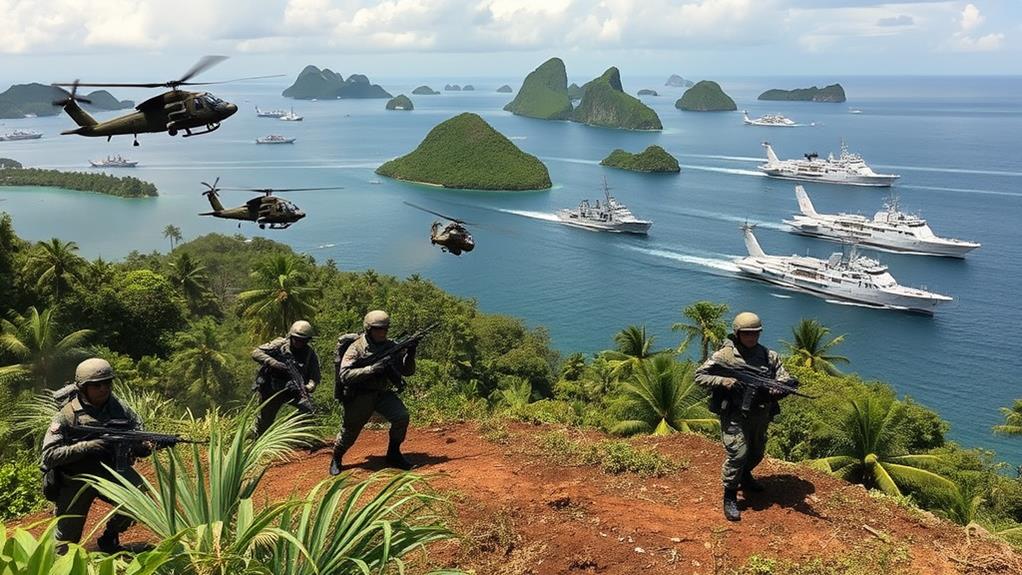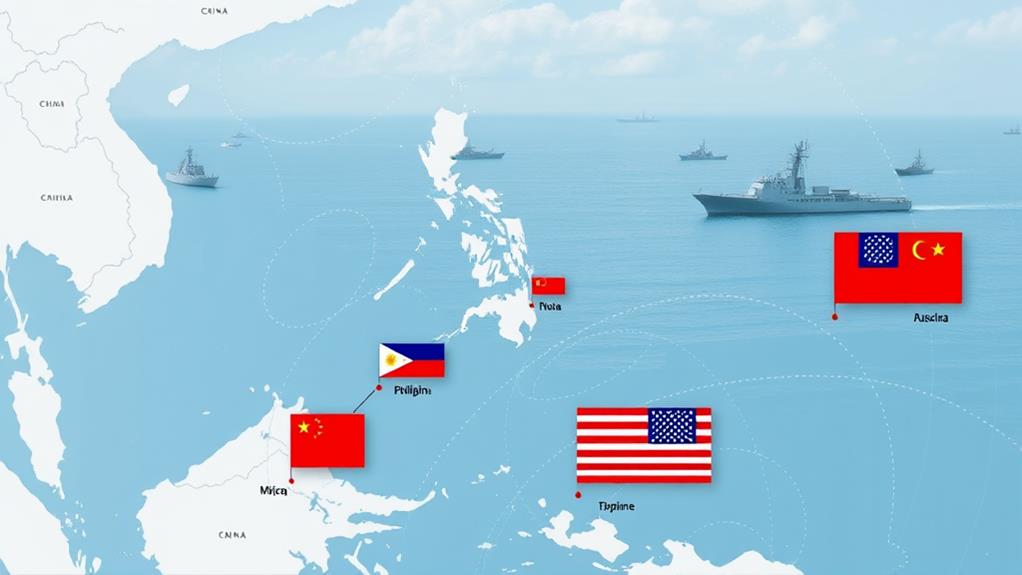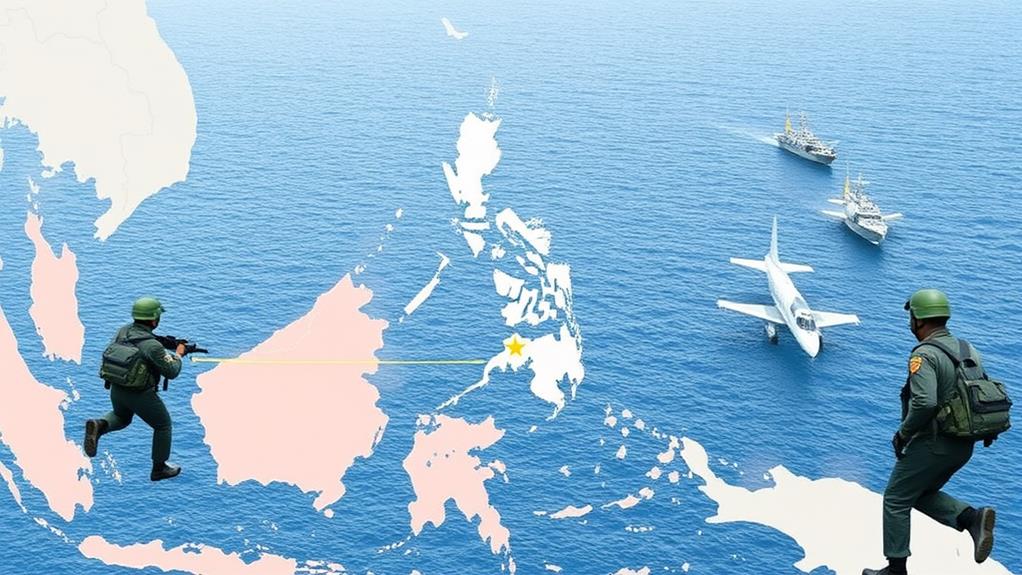The United States has a significant impact on Philippine geopolitics due to their century-long alliance.
This alliance began in 1898 when the Philippines became a U.S. territory. Today, the Philippines is a key U.S. treaty ally in Southeast Asia, strategically located to counterbalance Chinese influence in the South China Sea.
The U.S. enhances Philippine security through agreements and joint military exercises.
For instance, the Enhanced Defense Cooperation Agreement (EDCA) allows for greater U.S. military presence in the Philippines.
Additionally, joint military exercises like "Balikatan" strengthen the partnership between the two countries.
The U.S. also supports economic growth in the Philippines through investments.
Investments in sectors like semiconductors and renewable energy contribute to the country's economic development.
The U.S.-Philippines partnership is crucial for regional stability.
As tensions in the region escalate, this partnership plays a vital role in maintaining stability. Its evolution continues to shape the geopolitical landscape, and exploring this alliance further will reveal more about its impact on the region's future.
Historical Context of U.S.-Philippines Alliance

The U.S.-Philippines alliance has a complex and storied history spanning over a century. This relationship began in 1898 when the Philippines became a U.S. territory following the Spanish-American War. The U.S. battled Philippine revolutionary forces to consolidate control, and by 1902, the U.S. oversaw a civilian administration of the Philippines until 1935.
The historical context of U.S. involvement is exemplified by significant events like the Battle of Bataan during World War II. This battle demonstrated the commitment of both nations as they fought together against Japanese forces. The 1934 Tydings-McDuffie Act laid out a framework for formal independence within ten years, which eventually led to Philippine independence on July 4, 1946, after World War II.
The Mutual Defense Treaty signed in 1951 marked the beginning of a formal defense alliance between the two nations. This treaty ensured mutual defense commitments and has remained a cornerstone of their relationship despite fluctuations in their cooperation.
In the post-Cold War era, the alliance saw a significant shift as the U.S. exited Philippine military bases in 1991, only to re-engage through the Visiting Forces Agreement in 1997.
Throughout the years, the alliance has adapted to emerging security challenges, particularly with China's increasing assertiveness in the South China Sea. Recent developments, such as the Enhanced Defense Cooperation Agreement (EDCA) and joint military exercises, have strengthened their bilateral security cooperation.
Geopolitical Significance of the Philippines
The Philippines' Strategic Location
The Philippines' positioning at the crossroads of the Indo-Pacific makes it a crucial player in regional geopolitics. Its location at the outer rim of maritime Southeast Asia allows it to serve as a gateway between the Western Pacific and the rest of Asia, making its proximity to critical sea routes and sea lines of communication (SLOCs) highly significant.
Geopolitical Significance
The Philippines is situated at the center of the intense power competition between the United States and China. The U.S. is its traditional treaty ally, while China is its most powerful immediate neighbor.
The historical context of the Bataan Death March highlights the enduring legacy of U.S.-Philippine relations and the sacrifices made during WWII, which continue to influence contemporary geopolitical dynamics.
Regional Security
The Philippines' unique geography and role in ASEAN security affairs make it a key stakeholder in the South China Sea conflict. Its economic geography puts it in the spotlight of changing trade dynamics, supply chains, and shipping routes, emphasizing its importance in maintaining open and navigable waterways.
Regional Stability
The Philippines' ability to navigate complex relationships with both the U.S. and China, while balancing its own security needs, underscores its crucial role in maintaining regional stability.
Its strategic positioning and multifaceted relationships make it a linchpin in the Indo-Pacific's geopolitical future.
Economic Cooperation Initiatives

The Philippines has been actively fostering economic cooperation initiatives to leverage its strategic location and diverse partnerships.
Through its participation in regional forums like the Asia-Pacific Economic Cooperation (APEC), the Philippines engages in dialogue and cooperation with 20 other economies to promote free and open trade, regional economic integration, and human security. For instance, the Boracay Action Agenda to Globalize MSMEs aims to integrate micro, small, and medium enterprises into global markets, enhancing the country's economic growth and prosperity.
In addition to multilateral efforts, the Philippines has strengthened bilateral economic cooperation, notably with the United States.
A recent Presidential Trade and Investment Mission to Manila highlighted investments in the Philippines' innovation economy, clean energy transition, and supply chain resilience. The two countries are also collaborating on semiconductor development, critical minerals, and renewable energy projects, further solidifying their economic ties.
These collaborations demonstrate the Philippines' commitment to inclusive growth, innovation, and regional economic integration, positioning it as a dynamic player in the global economy.
By developing sustainable tourism, the Philippines can benefit from its rich natural resources, including its stunning underwater landscapes and vibrant marine sanctuaries.
Security Cooperation and Modernization
Security Cooperation and Modernization
The Philippines is committed to regional stability and defense through security cooperation and modernization.
Strengthening Alliance with the United States
The Philippines has significantly bolstered its alliance with the United States, with a recent $500 million commitment in foreign military financing. This investment aims to enhance the Armed Forces of the Philippines and the Philippine Coast Guard.
Modernizing the Philippine Military
The country is shifting its focus from internal security to external defense, particularly maritime security. This effort is guided by the Philippines-Security Sector Assistance Roadmap, which prioritizes defense investments and procurements.
Key Aspects of Cooperation
Financial Commitment: The United States has committed $500 million in foreign military financing.
Modernization Focus: The investment will focus on intelligence, surveillance, and reconnaissance, as well as maritime security.
Strategic Agreements: The Philippines has entered into strategic agreements, including the Enhanced Defense Cooperation Agreement (EDCA) and the Mutual Defense Treaty.
Infrastructure Development: The Philippines will invest $128 million in EDCA sites, including airfield infrastructure.
Regional Coordination: The country is cooperating with Japan and Australia through exercises and joint activities.
These initiatives aim to enhance interoperability, deter coercion, and ensure a rules-based order in the Indo-Pacific region.
Joint Military Exercises and Training

The Philippines Enhances Defense Capabilities through Joint Exercises
The Philippines engages in extensive joint military exercises and training programs to strengthen its defense capabilities and interoperability with allies.
The annual "Balikatan" exercise, involving thousands of Filipino and American troops, focuses on various domains such as maritime security, air and missile defense, cyber defense, and information operations. From April 22 to May 10, 2024, these drills simulate complex scenarios like retaking enemy-occupied islands, highlighting the strategic importance of the South China Sea and the Taiwan Strait.
Strengthening Military Ties through Joint Operations
The Philippines and the U.S. have established a Joint Operations Center (JOC) as part of Exercise Salaknib 2024.
This center facilitates real-time information sharing, joint planning, and execution of military operations, enhancing the readiness and capabilities of participating forces. These joint exercises demonstrate the commitment of both nations to regional security and stability, despite criticisms from China.
The collaborative approach allows both militaries to hone their skills, address security challenges, and foster deeper strategic cooperation.
Addressing Natural Disasters and Civil Needs
The Philippines, situated in the Pacific Ring of Fire, is prone to natural disasters like typhoons, earthquakes, and volcanic eruptions.
The country's geographical location makes it one of the most disaster-prone in the world.
To address natural disasters, several key initiatives are critical:
Civil-Military Coordination ensures principled coordination between civilian and military entities, maintaining humanitarian independence and avoiding political bias.
This initiative allows for effective resource allocation and response efforts during disasters.
Community-Based Resilience fosters local capacities through community-based initiatives, strengthening community resilience and preparedness.
For example, community-based projects can provide training on disaster preparedness, evacuation procedures, and first aid response.
Early Warning Systems provide timely and accurate flood and landslide information, enhancing emergency response and evacuations.
These systems can detect early signs of natural disasters, allowing for prompt warnings and evacuations, which can save lives and reduce damage.
Institutional Strengthening empowers local government units and civic groups, improving risk management and access to resources.
This initiative enhances the capacity of local authorities to respond to disasters, ensuring they've the necessary resources and expertise.
Social Support targets vulnerable populations, including farmers and marginalized communities, reducing poverty and inequality, and enhancing overall resilience.
This initiative provides essential assistance to those most affected by natural disasters, ensuring their basic needs are met during times of crisis.
International partnerships and government programs, such as the SHIELD initiative, combine national capabilities with local knowledge to build resilience against disasters.
Countering Chinese Influence Operations

The Philippines must navigate the complex geopolitical landscape with vigilance as China intensifies its efforts to consolidate its presence in the South China Sea.
China's influence operations often target the Filipino national debate, aiming to distort perceptions of sovereign competition.
These operations are often covert and coercive, using methods like co-optation, self-censorship, inducements, and intimidation.
Historically, the Philippines has relied on its waterways to facilitate trade and communication, underscoring the importance of maintaining sovereignty over its maritime routes.
The Pasig River, for example, has played a significant role in the country's trade and communication.
To counter Chinese influence operations, the United States plays a pivotal role. Washington can support Manila by promoting a deeper understanding of the United Front Work Department's activities, enhancing the Philippine intelligence community's ability to recognize and counter Chinese propaganda.
The US can also bolster its strategic partnerships with the Philippines by expanding the 2014 Enhanced Defense Cooperation Agreement (EDCA), increasing access to basing for US forces and solidifying a positive trajectory in regional cooperation.
This demonstrates a clear commitment to defending Philippine interests against Chinese encroachment.
How Will the Role of the United States Impact the Future of Philippine Geopolitics?
The future of philippine geopolitics will undeniably be influenced by the role of the United States. As a major superpower, the US has the capability to shape international relations and strategic alliances in the region, which will have a direct impact on the geopolitical landscape of the Philippines.
Strategic Implications for the South China Sea
The Philippines is a crucial partner for the United States in countering China's growing influence in the South China Sea. The country's strategic location between the Spratly and Paracel islands and its proximity to key straits like Luzon and Malacca make it a vital territory for U.S. interests.
Historical fortifications like Corregidor Island's military installations highlight the Philippines' importance in defending maritime routes.
The U.S. "Pivot to Asia" doctrine aims to contain Chinese military expansion by strengthening alliances with regional partners like the Philippines. This involves enhancing the military capabilities of the Philippine forces and modernizing their defenses. The U.S. also ensures a constant military presence in the region to deter Chinese aggression.
Joint military exercises like the "Balikatan" maneuvers demonstrate collaborative efforts to maintain maritime security.
The strategic partnership between the U.S. and the Philippines includes economic and diplomatic components. The U.S. invests in the Philippines' economic growth and security modernization to bolster its role as a key player in the Indo-Pacific.
This multifaceted approach is crucial for maintaining stability and security in the South China Sea, thereby countering China's assertive claims and actions.
Future of U.S.-Philippines Bilateral Relations

The future of U.S.-Philippines bilateral relations is being shaped by several key developments, particularly in the context of escalating tensions in the South China Sea.
Strengthening Commitments: Recent high-level engagements between the two countries have laid a strong foundation for deeper cooperation. For example, President Ferdinand R. Marcos, Jr.'s official visit to the White House in May 2023 reinforced commitments to advance the alliance in areas such as defense, economic ties, education, and human rights.
Shared History: The shared experiences of the two nations, including the sacrifices made during World War II, such as the Bataan Death March, have strengthened the bond between them.
The bilateral relationship is expected to expand through various initiatives:
Economic Cooperation: The U.S. is planning a Presidential Trade and Investment Mission to the Philippines to boost investments in innovation, clean energy, and critical minerals sectors.
Security Partnerships: The countries have strengthened their commitment to modernizing their alliance under the Mutual Defense Treaty (MDT), Visiting Forces Agreement (VFA), and Enhanced Defense Cooperation Agreement (EDCA).
Infrastructure Development: Joint projects like the Luzon Economic Corridor will accelerate investments in high-quality infrastructure, including rail, ports, and clean energy.
These efforts signify a proactive approach to fostering a robust and resilient partnership, crucial for addressing regional challenges and ensuring a free and open Indo-Pacific.
Questions and Answers
How Does the U.S.-Philippines Alliance Impact Local Communities in the Philippines?
The U.S.-Philippines alliance has a significant impact on local communities in the Philippines.
Infrastructure upgrades at EDCA facilities create jobs and stimulate economic growth in nearby areas. For instance, the renovation of the Basa Air Base in Pampanga province is expected to generate employment opportunities and increase local income.
Moreover, the alliance provides development assistance for local areas, enhancing their capabilities for disaster response and humanitarian aid.
This support enables local governments to respond more effectively to natural disasters and provide essential services to affected communities.
These efforts improve living conditions and economic opportunities, leading to a more stable and prosperous environment for local populations.
What Role Do Philippine Citizens Play in Shaping Foreign Policy With the U.S.?
Philippine citizens significantly influence foreign policy with the U.S. through their impact on domestic politics. Their opinions, especially from the security community and civil society, can shape policy directions.
For instance, there have been differing views between the Duterte administration and security elites on U.S.-China relations, demonstrating the power of public opinion.
Citizens' participation in democratic processes and engagement with policymakers ensure that national interests are aligned with foreign policy decisions. This leads to a more responsive and inclusive approach, as seen in the shaping of foreign policy with the U.S.
Are There Any Cultural Exchanges Between the U.S. and the Philippines?
Cultural exchanges between the U.S. and the Philippines do exist through various programs.
The Exchange Visitor Program (EVP) is one example, which allows Filipino educators to teach in the U.S. and promotes mutual understanding and cultural exchange.
This program facilitates the entry of Filipino educators to teach in American schools, fostering diversity and inclusivity.
How Does the Alliance Affect the Philippines' Relationships With Other ASEAN Nations?
The U.S.-Philippines alliance plays a significant role in shaping the Philippines' relationships with other ASEAN nations.
This alliance strengthens the Philippines' diplomatic and military ties with other ASEAN members, particularly in countering Chinese expansion in the South China Sea. For instance, the alliance enables the Philippines to participate in joint naval exercises with other ASEAN nations, such as Vietnam and Malaysia, to promote regional security and stability.
However, some ASEAN members may view the alliance as aligning too closely with U.S. interests, potentially affecting regional dynamics and cooperation. This perception could lead to tensions and complexities in the Philippines' relationships with other ASEAN nations, such as Indonesia and Cambodia, which may prioritize a more independent regional stance.
What Are the Long-Term Economic Benefits for the Philippines From the Alliance?
The alliance with the U.S. brings significant long-term economic benefits to the Philippines.
Investments in key sectors are expected to increase, driven by initiatives like the U.S.-led Indo-Pacific Economic Framework (IPEF) and the Enhanced Defense Cooperation Agreement (EDCA).
Clean energy, agriculture, and digital infrastructure will see major investments.
These investments will lead to enhanced economic security, resilience, and innovation.
A bilateral free trade agreement may also be on the horizon, which would expand access to global markets.